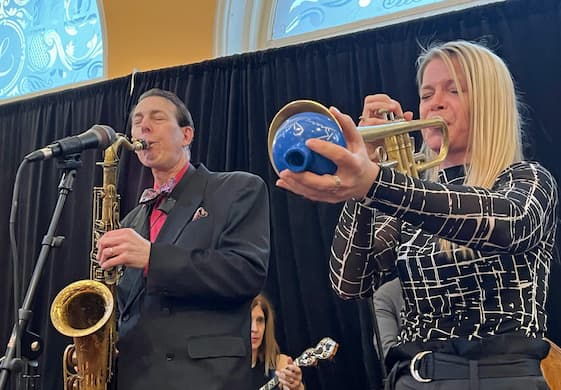Even After Pandemic Pause, Gotham Jazz Festival Proves a Miraculous Exercise
The fest focuses on earlier styles of jazz — New Orleans, ragtime, dixieland, blues, swing — in packing as much excitement as possible into a single, 11-hour-long day.

About halfway through Molly Ryan’s set at the Gotham Jazz Festival, she sang a risque blues number from 1924, “You’ve Got the Right Key, but the Wrong Keyhole.” The bridge of the song includes the following lines, “I’ve got a new man who is better than you. / He starts his loving where you get through.”
The sexual specifics of the text aside, it occurred to me that this is a fairly accurate metaphor for this event in general: It’s not merely the sheer quantity of bands (at least two dozen groups, usually with three or four playing at once in different rooms, employing more than 100 professional musicians) that stands out, but the practice of sequencing one right after another, each one starting where the previous band finished, each building on what came before.
This, the fifth edition of the Gotham Jazz Fest, took place early this week at the DTA at 60 Pine St.; the previous transpired before the pandemic in 2019. The event is produced by Patrick Soluri’s Prohibition Productions in conjunction with the New York Hot Jazz Camp, run by trumpeter Bria Skonberg and Ms. Ryan. The Gotham Fest, like its predecessor, the New York Hot Jazz Festival, focuses on earlier styles of jazz — New Orleans, ragtime, dixieland, blues, swing — and packs a miraculous amount of excitement into a single, 11-hour-long day.
The day began with guitarist Justin Poindexter and multi-instrumentalist Sasha Papernik’s Our Band, a multi-stylistic trio that spotlights the two leaders’ harmony vocals. Evidencing a decidedly international flair, they covered French gypsy-style jazz manouche, Brazilian choros, Argentine tangos, the basic blues, and the occasional jazz standard, such as “Lullaby of the Leaves” and one of many versions of Irving Berlin’s “Blue Skies” heard that day. Their standout number was an exotically European interpretation of Leonard Cohen’s “Dance Me to the End of Love.”
As before, the partnership with the New York Hot Jazz Camp was represented by a series of one-shot bands comprising students as well as faculty that performed throughout the afternoon. The central faculty band was, as billed, an all-star group with Ms. Skonberg, clarinetist Dan Levinson, trombonist Ron Wilkins, banjoist Cynthia Sayer, pianist Rossano Sportiello, bassist Tal Ronen, and drummer Kevin Dorn, plus four exceptionally vibrant numbers with singer Catherine Russell.
Cornetist Mike Davis’s New Wonders group offers a vivid homage to a specific variety of 1920s bands revolving around the general axis of the Frank Trumbauer/Bix Beiderbecke sessions, Red Nichols, and the California Ramblers. In that tradition they utilize Jay Rattman on bass saxophone rather than a string or a brass bass. The group plays expert arrangements — some vintage recreations, some new by Mr. Davis — varying between jazz age masterpieces like “Singin’ the Blues” and delightful ephemera like “When the Pussywillow Whispers to the Catnip.”
By the evening, the collective energy of the enmassed musical force was steadily mounting, becoming ever more palpable.
The Louis Armstrong Eternity Band, directed by tubaist David Ostwald has played Birdland every Wednesday for 23 years. Excellent as they are in a club, they positively sparkle in this informal festival setting. With a front line of Ms. Skonberg, clarinetist Ricky Alexander, and trombonist Jim Fryer, the band got hotter and hotter as it progressed toward its signature closer, “Swing that Music.”
When Molly Ryan and her new quintet, Manhattan Premier, took over, the excitement was fairly erupting — thanks not least to an entire floor full of supercharged dancers. The group co-starred Messrs. Levinson and Wilkins and the pianist du jour, Dalton Ridenhour, who played with at least half the bands heard that day. Ms. Ryan’s set balanced double entendre blues with swinging show tunes and a sparkling duet with Ms. Russell on “I Can’t Give You Anything But Love.”
After eight hours of listening and dancing, spirits were soaring and the dancers even more so as of 9 p.m. There were two 1940s-style swing and jump blues big bands that climaxed the day, trumpeter Danny Jonokuchi & The Revisionists and saxophonist Eyal Vilner’s Big Band.
At this point, the collective energy was off the charts: there were roughly 100 lindy hoppers on one side of the big ballroom, about 12 musicians in each group on the bandstand, and between them a couple of dozen of us wallflower listeners sat there feeding on the vibrations from all of the more active participants around us.
There’s a tradition among contemporary swing dancers to do what they call the “shim sham” to Jimmie Lunceford’s “’Tain’t What You Do (It’s the Way That You Do It).” I’ve witnessed this phenomenon before — the whole room explodes in a vintage line dance — but never had I seen a bandleader, such as Mr. Vilner, leap from the stage, dive into the middle of the floor, and then execute the dance steps with his feet even while continuing to play his lead alto part on the saxophone. There’s a first time, it is said, for everything.

